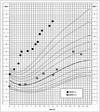Brain-derived neurotrophic factor and obesity in the WAGR syndrome
- PMID: 18753648
- PMCID: PMC2553704
- DOI: 10.1056/NEJMoa0801119
Brain-derived neurotrophic factor and obesity in the WAGR syndrome
Erratum in
- N Engl J Med. 2008 Sep 25;359(13):1414
Abstract
Background: Brain-derived neurotrophic factor (BDNF) has been found to be important in energy homeostasis in animal models, but little is known about its role in energy balance in humans. Heterozygous, variably sized, contiguous gene deletions causing haploinsufficiency of the WT1 and PAX6 genes on chromosome 11p13, approximately 4 Mb centromeric to BDNF (11p14.1), result in the Wilms' tumor, aniridia, genitourinary anomalies, and mental retardation (WAGR) syndrome. Hyperphagia and obesity were observed in a subgroup of patients with the WAGR syndrome. We hypothesized that the subphenotype of obesity in the WAGR syndrome is attributable to deletions that induce haploinsufficiency of BDNF.
Methods: We studied the relationship between genotype and body-mass index (BMI) in 33 patients with the WAGR syndrome who were recruited through the International WAGR Syndrome Association. The extent of each deletion was determined with the use of oligonucleotide comparative genomic hybridization.
Results: Deletions of chromosome 11p in the patients studied ranged from 1.0 to 26.5 Mb; 58% of the patients had heterozygous BDNF deletions. These patients had significantly higher BMI z scores throughout childhood than did patients with intact BDNF (mean [+/-SD] z score at 8 to 10 years of age, 2.08+/-0.45 in patients with heterozygous BDNF deletions vs. 0.88+/-1.28 in patients without BDNF deletions; P=0.03). By 10 years of age, 100% of the patients with heterozygous BDNF deletions (95% confidence interval [CI], 77 to 100) were obese (BMI > or = 95th percentile for age and sex) as compared with 20% of persons without BDNF deletions (95% CI, 3 to 56; P<0.001). The critical region for childhood-onset obesity in the WAGR syndrome was located within 80 kb of exon 1 of BDNF. Serum BDNF concentrations were approximately 50% lower among the patients with heterozygous BDNF deletions (P=0.001).
Conclusions: Among persons with the WAGR syndrome, BDNF haploinsufficiency is associated with lower levels of serum BDNF and with childhood-onset obesity; thus, BDNF may be important for energy homeostasis in humans.
2008 Massachusetts Medical Society
Figures



Comment in
-
The power of the extreme in elucidating obesity.N Engl J Med. 2008 Aug 28;359(9):891-3. doi: 10.1056/NEJMp0805396. N Engl J Med. 2008. PMID: 18753645 No abstract available.
Similar articles
-
Association of brain-derived neurotrophic factor (BDNF) haploinsufficiency with lower adaptive behaviour and reduced cognitive functioning in WAGR/11p13 deletion syndrome.Cortex. 2013 Nov-Dec;49(10):2700-10. doi: 10.1016/j.cortex.2013.02.009. Epub 2013 Feb 19. Cortex. 2013. PMID: 23517654 Free PMC article.
-
The modifier effect of the BDNF gene in the phenotype of the WAGRO syndrome.Gene. 2013 Mar 10;516(2):285-90. doi: 10.1016/j.gene.2012.11.073. Epub 2012 Dec 21. Gene. 2013. PMID: 23266638
-
Characterization of 11p14-p12 deletion in WAGR syndrome by array CGH for identifying genes contributing to mental retardation and autism.Cytogenet Genome Res. 2008;122(2):181-7. doi: 10.1159/000172086. Epub 2008 Dec 18. Cytogenet Genome Res. 2008. PMID: 19096215
-
Congenital diaphragmatic hernia in WAGR syndrome.Am J Med Genet A. 2005 May 1;134(4):430-3. doi: 10.1002/ajmg.a.30654. Am J Med Genet A. 2005. PMID: 15779010 Review.
-
Rare Syndromes and Common Variants of the Brain-Derived Neurotrophic Factor Gene in Human Obesity.Prog Mol Biol Transl Sci. 2016;140:75-95. doi: 10.1016/bs.pmbts.2015.12.002. Epub 2016 Feb 3. Prog Mol Biol Transl Sci. 2016. PMID: 27288826 Review.
Cited by
-
The BDNF gene Val66Met polymorphism as a modifier of psychiatric disorder susceptibility: progress and controversy.Mol Psychiatry. 2015 Aug;20(8):916-30. doi: 10.1038/mp.2015.27. Epub 2015 Mar 31. Mol Psychiatry. 2015. PMID: 25824305 Review.
-
Obesity genetics in mouse and human: back and forth, and back again.PeerJ. 2015 Mar 24;3:e856. doi: 10.7717/peerj.856. eCollection 2015. PeerJ. 2015. PMID: 25825681 Free PMC article. Review.
-
A case of WAGR syndrome in association with developmental glaucoma requiring bilateral Baerveldt glaucoma implants and subsequent tube repositioning.Clin Ophthalmol. 2015 Jun 15;9:1081-4. doi: 10.2147/OPTH.S80444. eCollection 2015. Clin Ophthalmol. 2015. PMID: 26109842 Free PMC article.
-
TrkB receptor signaling in the nucleus tractus solitarius mediates the food intake-suppressive effects of hindbrain BDNF and leptin.Am J Physiol Endocrinol Metab. 2012 May 1;302(10):E1252-60. doi: 10.1152/ajpendo.00025.2012. Epub 2012 Feb 28. Am J Physiol Endocrinol Metab. 2012. PMID: 22374757 Free PMC article.
-
Haematopoietic cells produce BDNF and regulate appetite upon migration to the hypothalamus.Nat Commun. 2013;4:1526. doi: 10.1038/ncomms2536. Nat Commun. 2013. PMID: 23443554 Free PMC article.
References
-
- Wang C, Bomberg E, Levine A, Billington C, Kotz CM. Brain-derived neurotrophic factor in the ventromedial nucleus of the hypothalamus reduces energy intake. Am J Physiol Regul Integr Comp Physiol. 2007;293:R1037–R1045. - PubMed
-
- Pelleymounter MA, Cullen MJ, Wellman CL. Characteristics of BDNF-induced weight loss. Exp Neurol. 1995;131:229–238. - PubMed
-
- Levin BE. Neurotrophism and energy homeostasis: perfect together. Am J Physiol Regul Integr Comp Physiol. 2007;293:R988–R991. - PubMed
Publication types
MeSH terms
Substances
Grants and funding
LinkOut - more resources
Full Text Sources
Other Literature Sources
Medical
Molecular Biology Databases
Miscellaneous
